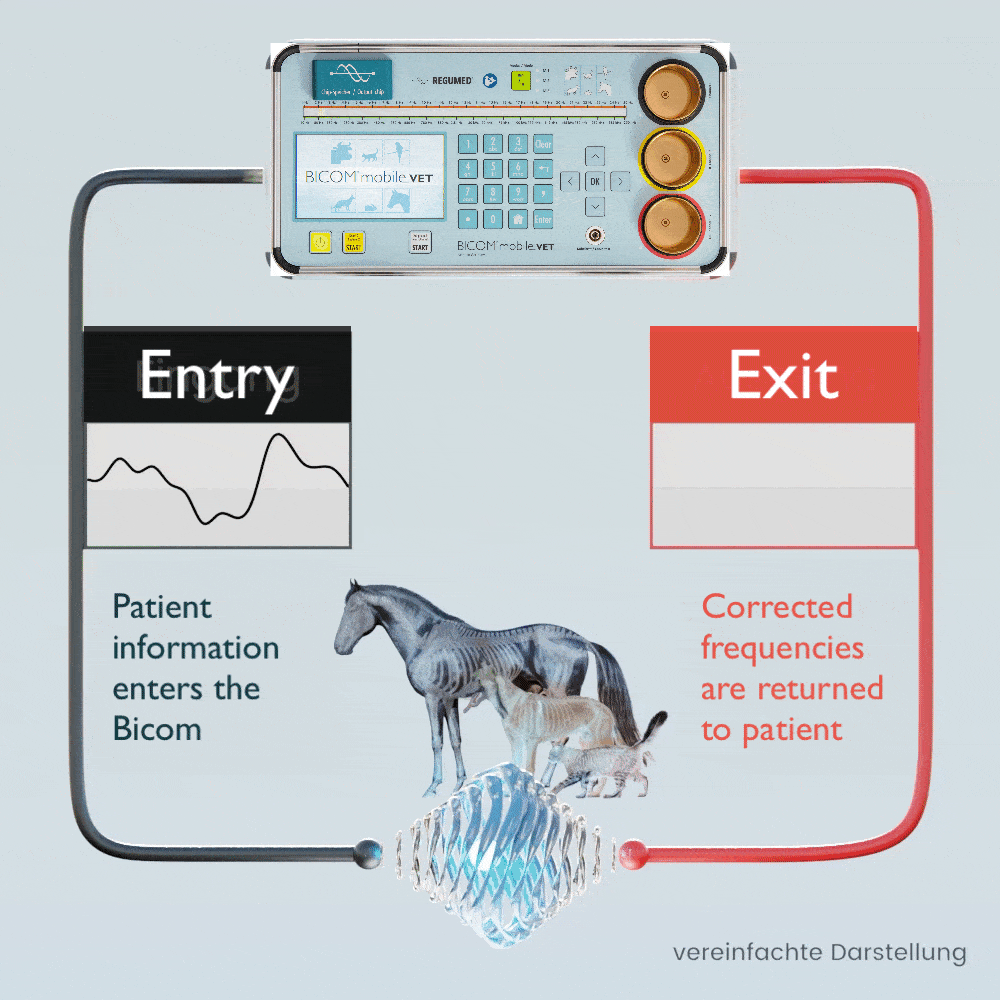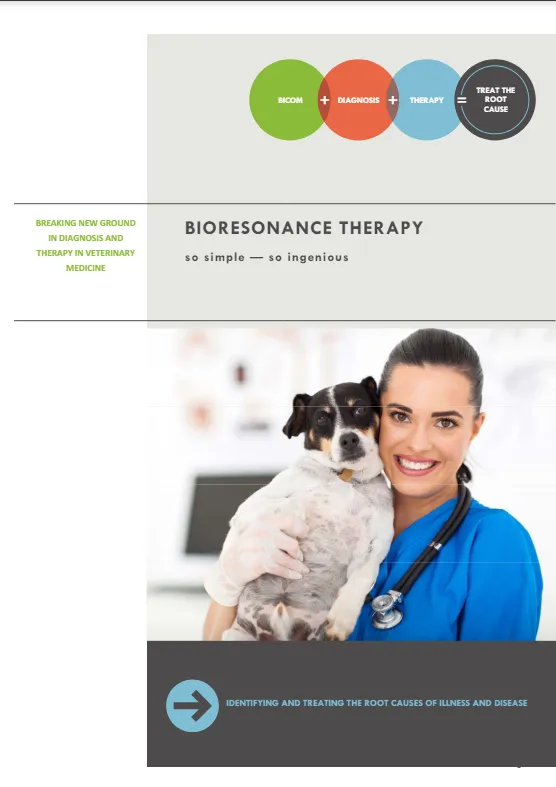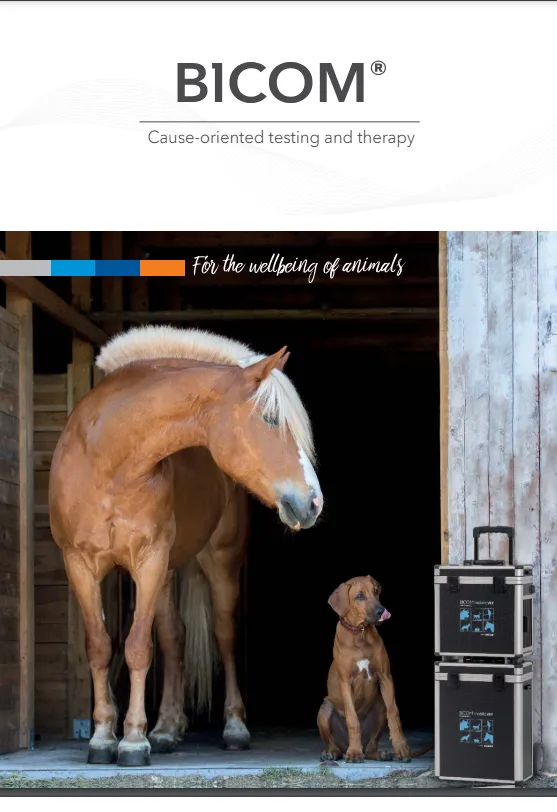Treatment with the help of the patient’s own information
in the BICOM® mobile VET bioresonance device
In contrast to other “frequency therapy devices”, BICOM® bioresonance is a method that is highly individual and perfectly tailored to the needs of the patient through the use of the patient’s own information and the possibility of testing specific wave patterns for resonance.
The patient’s own pathological and physiological information is recorded using special applicators and fed into the BICOM® mobile VET.
Depending on the therapy program, the specific wave pattern as a carrier of information is amplified, weakened or inverted and transmitted back to the patient in modulated form, which means that the transmission of information changes in clarity depending on the modulation or it disappears completely.
The treatment signals continuously adapt to the changing pathological situation of the patient. As the therapy progresses, the body’s ability to regulate is reactivated.
Find out more about this topic at our regular events. Together with veterinarians and animal naturopaths, we offer various face-to-face and online events .
The BICOM® bioresonance method is a cause-oriented, holistic treatment concept. It can narrow down the cause of the health problem in animals and find out even the hidden causes of the clinical picture.
Animals have a natural regulatory system that can also compensate for unusual influences. However, even good self-healing powers eventually reach their limits. Persistent exposure to allergens, environmental toxins, fungi, viruses, bacteria or stress and changed living conditions weaken the immune system and are often the cause of an illness. In particular, fungal infestation on the skin or chronic diseases in general are not always due to a breeding-related genetic defect, but are signs of a disturbed immune system.
The BICOM® bioresonance method is the key to successful diagnosis and therapy, especially for animals that cannot tell us exactly where it hurts or what the symptoms are. It is a gentle form of therapy that can be carried out without side effects and without additional stress for the animal.
The BICOM® mobile VET records the bioenergetic state of the animal, processes the information it contains and returns modified vibrations / therapy frequency patterns to the animal. Symptoms and stress can be diagnosed and targeted therapy can be initiated.
Through the use of endogenous and exogenous substances, the body’s own self-healing powers can be activated and imbalances that have existed for a long time can also be regulated.
REGUMED Medizintechnik are pioneers of the BICOM® bioresonance method. More than 30,000 therapists worldwide, well over 10,000 of them in Germany, successfully use their therapy concept.

Biophysical basics of the bioresonance method
Life is only possible when three conditions are met: matter, energy and information.
We also find these aspects in conventional medicine, both in diagnostics and in therapy. For example, every drug is also a carrier of information.
Information is neither energy nor matter, it is immaterial and comparable to the meaning of a message from a sending to a receiving system.
In addition to the electrical processes in the receptor proteins and biomembranes in general, electromagnetic interactions through light (biophotons) also play a role in cell communication and the transmission of information.
Specific electromagnetic wave patterns act as information carriers. These wave patterns can be modulated by the BICOM® device in order to eliminate disturbing or stressful information in an organism.
The goal is to restore the free flow of healing information (cell communication) and thus support the self-regulation of the organism and the self-healing powers.
Individual, patient-specific information or information from native substances, digitized substances or information stored on storage media can be used for therapy.
What your colleagues are saying…

Bioresonance Therapy And Food Allergy Testing
Allergies are not only annoying and inconvenient, but they can also be extremely dangerous and even life-threatening in some cases. While some people have no allergies, there are a lot of people who suffer from multiple allergies. Allergies affect a large number of people. According to the American College of Allergy, Asthma and Immunology, approximately 6% of American children and 4% of American adults are affected by some kind of allergy. Food allergies, in particular, are relatively common, and can have quite a large impact on a person’s life when they suddenly start to experience allergic reactions to some of their favorite foods.
A food allergy can develop at any time, and a person can experience an allergic reaction to almost any kind of food. This reaction occurs when a person consumes something that causes their immune system to overreact. When their immune system overreacts, it treats certain particles found in the food that was consumed as pathogenic substances; thus sending out certain types of chemicals to help defend the body against these “false pathogens”.
Most Common Food Allergies
People can become allergic to almost all foods. Some people may eat a certain type of food one day and feel perfectly find after eating, but experience an allergic reaction the next time they eat that particular type of food. There are some food allergies that are considered much more common than others.
According to the Centers for Disease Control and Prevention, approximately 90% of all recorded food allergies account for one of eight specific food types. These particular food types that seem to cause allergic reactions in most cases where such a reaction is experienced include eggs crustacean shellfish, tree nuts, peanuts, milk, soy, wheat and fish.
Symptoms Of Food Allergies
Knowing which symptoms to look out for when it comes to food allergies is important. Stopping such an allergic reaction as soon as it starts can help a person avoid potentially life-threatening symptoms. It should also be noted that certain symptoms are considered mild, while others are considered more severe. Knowing how to differentiate between mild and severe symptoms is essential to know which treatment method would be most appropriate for the situation.
According to FARE (Food Allergy Research & Education), some common symptoms that signal a mild to moderate allergic reaction to food usually includes hives, which may consist of itchy areas that develop on the skin, accompanied by inflammation and redness. The skin around the eyes and mouth often also becomes red when a food allergy is experienced. The ear canal or mouth may become itchy, and a person may start sneezing, experience a runny nose or nasal congestion.
In some cases, an odd taste may be experienced in a person’s mouth. There are also cases where a person experiences a stomach pain. Nausea and vomiting are also common symptoms of an allergic reaction to food.
What Is Anaphylaxis?
In some cases, a more severe allergic reaction may be experienced to certain types of food. Left untreated, the condition may become life-threatening. This reaction is called anaphylaxis and can lead to death should it not be treated immediately. Signs to be wary of include difficulty swallowing, not being able to breathe properly, a fast reduction in blood pressure, fainting and sudden weakness, a weak pulse, chest pain and a loss of consciousness.
How Is Food Allergies Tested?
Food allergies can be tested in different ways. When a person visits their doctor, the doctor may order an allergy test to better determine the particular foods and particles the patient is allergic to. Thereafter, appropriate treatment methods can be implemented, including avoiding the foods that the allergy test listed during the test.
A basic skin test is often the preferred method of testing for food allergies. During such a test, small drops will be placed on the patient’s skin. The skin will also be pricked and a period of approximately 20 minutes has to pass in order to determine which foods a patient may be allergic to. If bumps develop in certain spots, it means the patient is allergic to the particular food types that were tested at those locations. Additional blood tests are sometimes requested in addition to the skin test should further analysis be required.
How Bioresonance Therapy Is Used In Food Allergy Testing
Even though the most basic food allergy test is considered safe and not painful at all, the fact that the skin needs to be pricked is certainly not pleasant for many people. Thus, people with food allergies often seek out alternative methods to test their allergies. Bioresonance therapy is often a preferred alternative method, offering a safe and much less invasive method of testing for particular foods that a person may experience allergic reactions to.
With bioresonance therapy, electromagnetic waves of certain foods have been programmed into the BICOM device utilized during the test. A DNA sample of the patient is then taken and different electromagnetic waves are then emitted toward the DNA sample collected. The BICOM device provides the practitioner with information regarding how the DNA sample reacts to the electromagnetic waves that are being sent to it. This provides the practitioner with details on particular types of foods that the body shows a sensitivity to. The more significant of a reaction, the higher the chance the patient can experience a more severe reaction to that particular type of food. This information is then utilized to provide the patient with an extensive overview of what foods their body is sensitive to and what foods they may be allergic to.
Conclusion
Experiencing food allergies is a problem that many people have to face. In many cases, an allergic reaction may be experienced with different types of food, and cutting all of these foods from one’s diet can become problematic if it would cause a significant restriction in the options available to the particular individual. With allergy testing, however, a diagnosis can be made to a deeper level; thus explaining what foods a person is allergic to, or pinpointing particular substances. While traditional methods for food allergy testing may seem a little invasive to some people, bioresonance therapy offers a safer, more convenient way that is in no way at all invasive.
Treatment Priorities
For gentle and optimal treatment of the causes of diseases in animals
The BICOM® bioresonance method is predestined for use with large and farm animals such as horses , but also with dogs , cats and small animals. The treatment focus of the BICOM® mobile VET is wide-ranging. It is now used for many indications.
It recognises health deficits at an early stage and is used, among other things, for the following symptoms:
sweet itch
Feed intolerances
allergies and related diseases
COB/COPD
leishmaniasis
Lyme disease
anaplasmosis
lameness in horses
hoof ulcer
Poisoning by poisoned baits, plants etc.
mauke
Feline infectious peritonitis (FIP)
Cat flu/cat disease
eye/conjunctivitis
and much more
Get advice now!
Our experts are happy to be there for you personally
Our BICOM® bioresonance experts are available to answer any questions you may have
and will be happy to advise you personally and individually.




Request more information
Quick Links





Facebook
Instagram
Mail